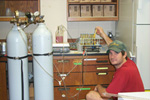Microbiologist probes depths for archeology
by Dick PetersonPublic Relations
Word gets around.
That’s how MUSC research scientist Pam Morris, Ph.D., sees it.
First she was tapped to bring her knowledge of microorganisms to the CSS Hunley. And then, grapevine fashion, the National Parks Service heard about her work and put her on a plane to Hawaii to visit the USS Arizona.
“I think I’ve been adopted by the National Park Service,” Morris said with a smile. Adopted at least for the underwater, sunken ship section of the National Park Service, referred to as the Submerged Resources Center. The service's concern is the slow, steady leak of heavy fuel oil from the holds of the USS Arizona, sunk by Japanese bombs in Pearl Harbor nearly 60 years ago.
And her connection to the Hunley? Here’s where it can get complicated.
 Master's
student, Jeff Retzke, holds an anaerobic test tube containing a geothite
amended media used to isolate iron reducing microorganisms from sediments
associated with the recently excavated civil war-era submarine, the H.L.
Hunley.
Master's
student, Jeff Retzke, holds an anaerobic test tube containing a geothite
amended media used to isolate iron reducing microorganisms from sediments
associated with the recently excavated civil war-era submarine, the H.L.
Hunley.
Morris' research discipline is in microorganisms, or microbes, and how they live, what they do, even what they eat in all sorts of environments—some with plenty of oxygen around, aerobic, and some with hardly any to none at all, anaerobic.
Those raising, restoring and preserving the Hunley, which sank off Sullivan’s Island on Feb. 17, 1864, after being the first submarine to sink a ship in battle, are concerned about the deterioration that has occurred during the past 136 years. They want to know how to stop it and maybe even reverse it, both on the vessel’s hull and in the sedimentation within.
Microbes played a huge role in the underwater condition of the vessel. So its caretakers want to know what they were, what they did, and how they did it. They are especially interested in how the microorganisms inside of the vessel differ from those outside, and how microorganisms were involved in the formation of the layer of concretions that cover the vessel’s hull.
And now that it's out of the seawater and in a tank of fresh water, they want to know how to slow the corrosion of the hull.
“We made four trips to the site back in May,” Morris said. “Divers, all of whom specialize in underwater archaeology, collected samples for us while we had voice communication with them. The visibility down there was near zero.” The divers took sediment core samples in a transect 20 meters from the vessel, as well as samples of the concretions on the hull. They also popped one of the submarine’s rivets and took several small core samples from the interior.
The microbe samples, now safely back at the lab, are being enriched to look for anaerobic organisms capable of iron and sulfate reduction. Morris explained that iron and sulfate reduction processes contribute to biocorrosion and the buildup of concretions. For example, microbial sulfate reduction results in the corrosive end product, hydrogen sulfide.
“By examining the ‘fingerprint’ of the microorganisms in that environment, we can know the conditions present through much of the time that sub was on the ocean floor,” Morris said. She explained that if the Hunley’s interior sediments were dominated by anaerobic microorganisms, that helps to better understand what conditions were present and how items may have been preserved over time.
“The sub is now in fresh water and the microbial community has changed,” Morris said.
“But the Hunley itself is in gorgeous shape, and surprisingly well built.” The archaeologists on the project expected a less sophisticated construction than what was revealed when the primitive submarine’s hull broke the surface Aug. 8.
Unlike the Hunley, the USS Arizona will not be raised. And that's central to the problem Morris is facing in Pearl Harbor. Sunk on Dec. 7, 1941, and its superstructure salvaged during the war, the Arizona has been made a memorial to the sailors who perished and remain buried with her. A monument to their sacrifice has been built on the site.
But even tourist brochures and post cards of the Arizona memorial show the oil slick streaming along the surface of the water above the ship. The oil slick moves in the direction of the prevailing current and trade winds, towards the Pacific Ocean.
“Divers report seeing globs of the heavy fuel oil seeping from some of the hatches,” Morris said. “We are testing the microbial degradability of the oil, which is also being chemically analyzed by a collaborator at Texas A&M University. It is a heavy oil, and I doubt if it is very degradable.”
She said another concern centers on where the oil goes when it leaves the sunken ship. If it disperses quickly into the Pacific Ocean, it presents little additional impact on an already contaminated harbor. For the time being, the oil does not seem to be collecting on the shoreline or presenting a significant hazard to sea life. But the National Park Service fears one day a section of the ship will open, release a large quantity of the fuel oil and create a much more serious problem.
“So, while scientists at the University of Nebraska look at rates of corrosion on the Arizona and for ways to slow it down, we study the microorganisms that might be contributing to the corrosion,” Morris said.
Morris is an environmental microbiologist with research interests in biodegradation of crude oil, and other contaminants, including polychlorinated biphenyls. She also researches the effects of uranium and nickel toxicity to microorganisms, and how these co-contaminants impact bioremediation strategies.
“And now I’ve been called on to study microorganisms from sunken ships,”
Morris said. “It will be interesting to determine how a microbiologist
can be used to help answer archeological questions.”